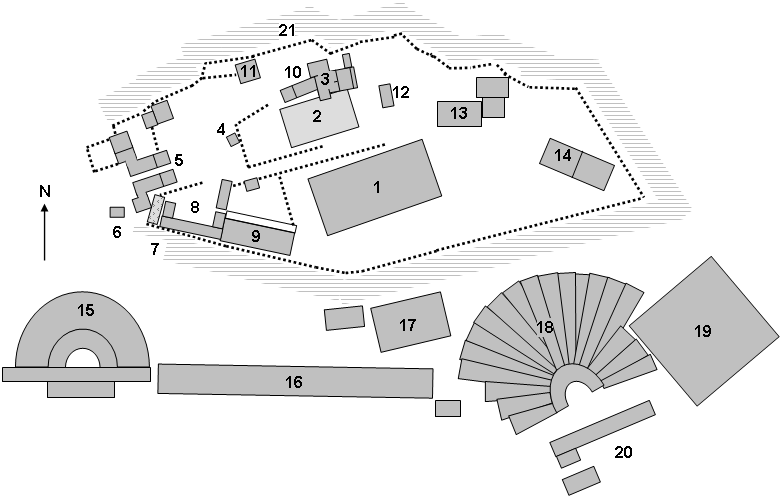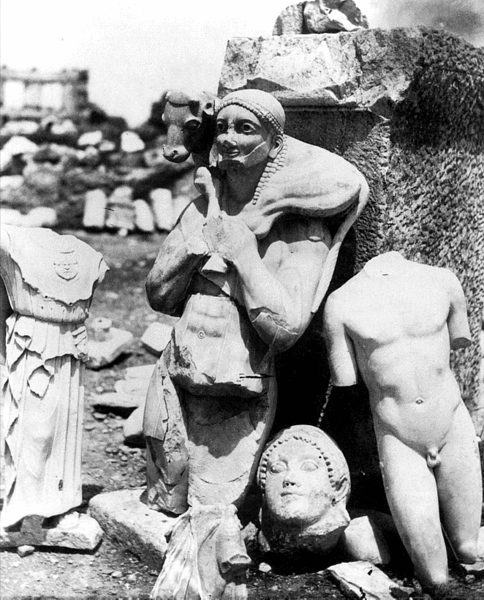|
Sanctuary Of Pandion
The Sanctuary of Pandion is the name sometimes given to the remains of a building located in the south-east corner of the Acropolis of Athens. Its foundations were found during the excavations for the construction of the Old Acropolis Museum (1865–1874). The 40m by 17m rectangular open-air building, dating to the later 5th century, was divided into two nearly equal parts by a wall. It faced west-northwest and was entered through a projecting portico on the western side. The name stems from the presumption that this was the location of the heroon (hero shrine) of Pandion, the eponymous hero of the Attic tribe Pandionis (usually assumed to be one of the two legendary kings of Athens, Pandion I or Pandion II), which was known to be located somewhere on the Acropolis.Jonespp. 157–158 Robertsonpp. 40–41 Pausanias1.5.4 Notes References * Jones, Nicholas F., ''The Associations of Classical Athens : The Response to Democracy: The Response to Democracy'', Oxford Universi ... [...More Info...] [...Related Items...] OR: [Wikipedia] [Google] [Baidu] |
Acropolis Of Athens
The Acropolis of Athens is an ancient citadel located on a rocky outcrop above the city of Athens and contains the remains of several ancient buildings of great architectural and historical significance, the most famous being the Parthenon. The word '' acropolis'' is from the Greek words (''akron'', "highest point, extremity") and (''polis'', "city"). The term acropolis is generic and there are many other acropoleis in Greece. During ancient times the Acropolis of Athens was known also more properly as Cecropia, after the legendary serpent-man, Cecrops, the supposed first Athenian king. While there is evidence that the hill was inhabited as far back as the fourth millennium BC, it was Pericles (c. 495–429 BC) in the fifth century BC who coordinated the construction of the buildings whose present remains are the site's most important ones, including the Parthenon, the Propylaea, the Erechtheion and the Temple of Athena Nike. The Parthenon and the other buildings were serio ... [...More Info...] [...Related Items...] OR: [Wikipedia] [Google] [Baidu] |
Old Acropolis Museum
The Old Acropolis Museum ( el, (Παλαιό) Μουσείο Ακρόπολης ''(Palaio) Mouseio Akropolis'') was an archaeological museum located in Athens, Greece on the archeological site of Acropolis. It is built in a niche at the eastern edge of the rock and most of it lies beneath the level of the hilltop, making it largely invisible. It was considered one of the major archaeological museums in Athens. Due to its limited size, the Greek government decided in the late 1980s to build a new museum. The New Acropolis Museum is now built at the foot of the Acropolis. In June 2007 the old museum closed its doors so that its antiquities could be moved to their new home, which opened on 20 June 2009. History The museum was home to many of the Greek world's ancient relics found in and around the Acropolis of Athens since excavations started. It was designed by architect Panagis Kalkos and was constructed between 1865 and 1874. It was expanded in the 1950s to a modern design exec ... [...More Info...] [...Related Items...] OR: [Wikipedia] [Google] [Baidu] |
Portico
A portico is a porch leading to the entrance of a building, or extended as a colonnade, with a roof structure over a walkway, supported by columns or enclosed by walls. This idea was widely used in ancient Greece and has influenced many cultures, including most Western cultures. Some noteworthy examples of porticos are the East Portico of the United States Capitol, the portico adorning the Pantheon in Rome and the portico of University College London. Porticos are sometimes topped with pediments. Palladio was a pioneer of using temple-fronts for secular buildings. In the UK, the temple-front applied to The Vyne, Hampshire, was the first portico applied to an English country house. A pronaos ( or ) is the inner area of the portico of a Greek or Roman temple, situated between the portico's colonnade or walls and the entrance to the ''cella'', or shrine. Roman temples commonly had an open pronaos, usually with only columns and no walls, and the pronaos could be as long as th ... [...More Info...] [...Related Items...] OR: [Wikipedia] [Google] [Baidu] |
Pandion (hero)
Pandion ( or ; Ancient Greek: Πανδίων) was the eponymous hero of the Attic tribe Pandionis, which was created as part of the tribal reforms of Cleisthenes at the end of the sixth century BC. He is usually assumed to be one of the two legendary kings of Athens, Pandion I or Pandion II. Pandion I and II The relationship between Pandion, the eponymous hero, and the two legendary Athenian kings Pandion I and Pandion II is unclear, but most sources assume that the hero was one or the other of these two kings. The situation is further complicated by the fact that either Pandion I or Pandion II may have been invented to fill a gap in the mythical history of Athens, and that originally there may have been only one Pandion. Demosthenes' Funeral Oration (338 BC) makes the father of the famous sisters Procne and Philomela—usually considered to be Pandion I—the eponymous hero of the Pandionidae. However, the 2nd century AD geographer Pausanias does not know which king Pand ... [...More Info...] [...Related Items...] OR: [Wikipedia] [Google] [Baidu] |
Phyle
''Phyle'' ( gr, φυλή, phulē, "tribe, clan"; pl. ''phylai'', φυλαί; derived from ancient Greek φύεσθαι "to descend, to originate") is an ancient Greek term for tribe or clan. Members of the same ''phyle'' were known as ''symphyletai'' ( gr, συμφυλέται), literally: ''fellow tribesmen''. They were usually ruled by a ''basileus''. Some of them can be classified by their geographic location: the Geleontes, the Argadeis, the Hopletes, and the Agikoreis, in Ionia; the Hylleans, the Pamphyles, the Dymanes, in the Dorian region. Attic tribes The best-attested new system was that created by Cleisthenes for Attica in or just after 508 BC. The landscape was regarded as comprising three zones: urban (''asty''), coastal ('' paralia'') and inland (''mesogeia''). Each zone was split into ten sections called ''trittyes'' ('thirdings'), to each of which were assigned between one and ten of the 139 existing settlements, villages or town-quarters, which were henceforth cal ... [...More Info...] [...Related Items...] OR: [Wikipedia] [Google] [Baidu] |
King Of Athens
Before the Athenian democracy, the tyrants, and the Archons, the city-state of Athens was ruled by kings. Most of these are probably mythical or only semi-historical. The following lists contain the chronological order of the title King of Athens (also prescribed earlier as kings of Attica), a semi-mythological title. Earliest kings These three kings were supposed to have ruled before the flood of Deucalion. Erechtheid dynasty The early Athenian tradition, followed by the 3rd century BC Parian Chronicle, made Cecrops, a mythical half-man half-serpent, the first king of Athens. The dates for the following kings were conjectured centuries later, by historians of the Hellenistic era who tried to backdate events by cross-referencing earlier sources such as the Parian Chronicle. Tradition says that King Menestheus took part in the Trojan War. The following list follows that of 1st Century BC Castor of Rhodes ( ''FGrHist'' 250), with Castor's dates given in modern terms. Melant ... [...More Info...] [...Related Items...] OR: [Wikipedia] [Google] [Baidu] |
Pandion I
In Greek mythology, Pandion I (; Ancient Greek: Πανδίων) was a legendary King of Athens, the son and heir to Erichthonius of Athens and his wife, the naiad Praxithea. Through his father, he was the grandson of the god Hephaestus. Family Pandion married a naiad, Zeuxippe, and they had two sons Erechtheus and Butes, and two daughters Procne and Philomela. In some accounts, he was also called the father of Teuthras, father of Thespius, and of Cephalus, lover of Eos (Dawn). Mythology Pandion I was the fifth king of Athens in the traditional line of succession as given by the third century BC Parian Chronicle, the chronographer Castor of Rhodes (probably from the late third-century Eratosthenes) and the '' Bibliotheca''. He was preceded by Cecrops I, Cranaus, Amphictyon, and Erichthonius, and succeeded by Erechtheus, Cecrops II, and Pandion II. Castor makes Pandion I the son of Erichthonius (the earliest source for this) and says he ruled for 40 years (1437/6–1397/6 ... [...More Info...] [...Related Items...] OR: [Wikipedia] [Google] [Baidu] |
Pandion II
In Greek mythology, Pandion II ( or ; Ancient Greek: Πανδίων) was a legendary King of Athens, the son and heir of King Cecrops II and his wife Metiadusa, daughter of Eupalamus. Family Pandion was the father of Aegeus, Pallas, Nisos, Lycus and the wife of Sciron by Pylia, daughter of King Pylas of Megara. Mythology Pandion II was the eighth king of Athens in the traditional line of succession as given by the third century BC Parian Chronicle, the chronographer Castor of Rhodes (probably from the late third-century Eratosthenes) and the '' Bibliotheca''. He was preceded by Cecrops I, Cranaus, Amphictyon, Erichthonius, Pandion I, Erechtheus, and Cecrops II, and succeeded by Aegeus and Theseus. Castor gives his reign as 25 years (1307/6–1282/1). Originally there may have been a single Pandion, and either Pandion I or Pandion II may have been a later invention in order to fill a gap in the mythical history of Athens. Pausanias calls this Pandion the father of Procne a ... [...More Info...] [...Related Items...] OR: [Wikipedia] [Google] [Baidu] |
Pausanias (geographer)
Pausanias ( /pɔːˈseɪniəs/; grc-gre, Παυσανίας; c. 110 – c. 180) was a Greek traveler and geographer of the second century AD. He is famous for his ''Description of Greece'' (, ), a lengthy work that describes ancient Greece from his firsthand observations. ''Description of Greece'' provides crucial information for making links between classical literature and modern archaeology. Biography Not much is known about Pausanias apart from what historians can piece together from his own writing. However, it is mostly certain that he was born c. 110 AD into a Greek family and was probably a native of Lydia in Asia Minor. From c. 150 until his death in 180, Pausanias travelled through the mainland of Greece, writing about various monuments, sacred spaces, and significant geographical sites along the way. In writing ''Description of Greece'', Pausanias sought to put together a lasting written account of "all things Greek", or ''panta ta hellenika''. Living in t ... [...More Info...] [...Related Items...] OR: [Wikipedia] [Google] [Baidu] |
Ancient Greek Buildings And Structures In Athens
Ancient history is a time period from the History of writing, beginning of writing and recorded human history to as far as late antiquity. The span of recorded history is roughly 5,000 years, beginning with the Sumerian language, Sumerian cuneiform script. Ancient history covers all continents inhabited by humans in the period 3000 BCAD 500. The three-age system periodizes ancient history into the Stone Age, the Bronze Age, and the Iron Age, with recorded history generally considered to begin with the Bronze Age. The start and end of the three ages varies between world regions. In many regions the Bronze Age is generally considered to begin a few centuries prior to 3000 BC, while the end of the Iron Age varies from the early first millennium BC in some regions to the late first millennium AD in others. During the time period of ancient history, the world population was already Exponential growth, exponentially increasing due to the Neolithic Revolution, which was in full pro ... [...More Info...] [...Related Items...] OR: [Wikipedia] [Google] [Baidu] |





